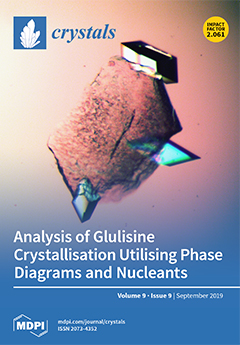The organic ligand (1-methyl-1
H-benzo[
d]imidazol-2-yl)methanol (HL) was used to react with CoX
2·6H
2O (X = Cl and Br) under solvothermal conditions to obtain the complex [Co
4(L)
6(X)
2] (1, X = Cl; 2,
[...] Read more.
The organic ligand (1-methyl-1
H-benzo[
d]imidazol-2-yl)methanol (HL) was used to react with CoX
2·6H
2O (X = Cl and Br) under solvothermal conditions to obtain the complex [Co
4(L)
6(X)
2] (1, X = Cl; 2, X = Br). The butterfly-shaped structure of complex 1 and 2 suggest that Co(II) ions have two different coordinated modes, which are five coordination with O
3NX environment and six coordination with O
4N
2 environment. In addition, the electrospray ionization mass spectrometry (ESI-MS) analysis indicated that the ion molecular fragment of highest intensity was [Co
4(L)
6]
2+, and there existed a high nuclear fragment peak of [Co
7(L)
12]
2+. Interestingly, it was basically completely transformed into [Co
7(L)
12]
2+ two days later, so those two complexes were relatively stable in CH
3OH. Magnetic characterization exhibited that complex 1 and 2 display field-induced single-molecule magnetic behavior, of which the energy hills
Ueff/
kB were 28 and 20 K under direct-current field of 0.1 T, respectively.
Full article





